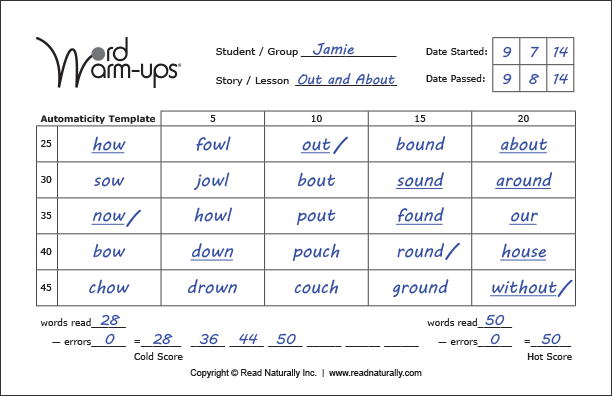Did you know there is a downward spiral of reading failure? It starts with the foundational skills. Beginning readers who have difficulty learning to read words accurately and fluently may continue on a downward spiral, making it harder and harder to catch up.
Research tells us that, in order to read fluently, students need to learn to decode unknown words accurately and automatically. Students who must use all of their mental energy to sound out words are not able to focus on the meaning of what they are reading (LaBerge and Samuels, 1974). In fact, research shows that those students who have not developed automaticity in decoding by the beginning of second grade are at risk for reading failure (Berninger et al., 2003, Berninger et al., 2006).
Most phonics programs teach students to decode accurately, but learning phonics does not guarantee that students are able to decode words automatically. An effective strategy for developing this skill is to have students practice with words on decoding worksheets—a strategy you can use with content from any reading program. The strategy involves teacher modeling, repeated reading, and progress monitoring.
Create columns of words—organized as word families or grouped together because of a similar pattern—to support students as they learn to read the words. Duplicate the prepared decoding worksheet for each student.

Above is an example with columns of words with the /ou/ sound (o-w and o-u). High-frequency words are underlined. In the first four columns, the words within each column rhyme or have similar features. The last column includes additional high-frequency words with the featured sound.
To use this strategy, time students for one minute before practicing to get a baseline score. Students should read quietly aloud down each column and then across each row. As students read down the columns, they’re generally supported by word families or a common sound/spelling pattern. As they read across the rows, they must carefully examine each word, because they do not have the benefit of word families or similar features. Tell students to underline any difficult words they cannot read quickly. When the timer sounds, students should put a vertical line after the last word read. They can use the numbers along the top and sides to quickly count words. Have each student record the number of words read, subtract any underlined words (errors), and record the score on the “Cold Score” line. The student can also record the cold score on a graph in blue to monitor progress after practicing.
.png)
Next, provide teacher modeling by having students read along with you (or another proficient reader) down each column to learn the words. Just listening isn’t enough. The students need to be looking at the words on their papers and reading quietly aloud with you.
Then, students do repeated reading by reading down each column and then across each row for several one-minute timings. You can time the whole group or teach students to use individual timers.
When a student is able to read all of the words down and across in one minute, time the student as you listen, note any errors, and record the final score on the “Hot Score” line. (If a student makes three or more errors, the student should continue practicing.) The student can record the hot score on the graph (in red) above the cold score (in blue) to visually monitor progress after practicing.
Try this strategy to build automaticity in phonics and word recognition with your students, using words from your current phonics program and high-frequency word list. A free phonics worksheet and graph are available for download here:
Printable samples and assessments of Word Warm-ups®, a leveled intervention program designed to develop automaticity, are also available here.
Berninger, V. W., K. Vermeulen, R. B. Abbott, D. McCutcheon, S. Cotton, J. Cude, S. Dorn, and T. Sharon. 2003. Comparison of three approaches to supplementary reading instruction for low-achieving second-grade readers. Language, Speech, & Hearing Services in Schools 34, pp. 101-116.
Berninger, V. W., R. B. Abbott, K. Vermeulen, and C. M. Fulton. 2006. Paths to reading comprehension in at-risk second-grade readers. Journal of Learning Disabilities 39, pp. 334-351.
LaBerge, D., & Samuels, S. J. (1974). Toward a theory of automatic information processing in reading. Cognitive Psychology, 6, 292–323.
 Share your student’s success story—nominate him or her for our Star of the Month award. Win a Barnes & Noble gift card for the student and a Read Naturally gift certificate for your class!
Share your student’s success story—nominate him or her for our Star of the Month award. Win a Barnes & Noble gift card for the student and a Read Naturally gift certificate for your class!
Kids enjoy these drills and like seeing their increase in this visual format!
Perfect for differentiated instruction.
Thank you for the two templates.